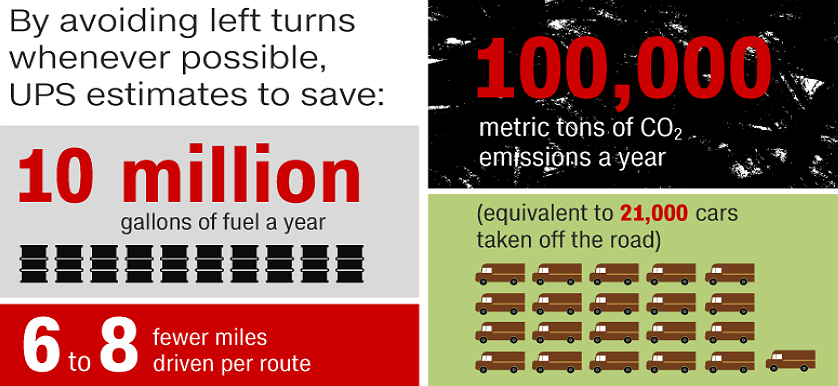United Parcel Service – A story of UPS and never-lefts

United Parcel Service, generally known as UPS, the world’s largest package delivery company and a provider of supply chain management solutions, maintains a practice that would seem quirky, to say the least, to most people: its trucks almost never turn left. Now, why is that so?
The company bases its practice on a rule that was put in place decades ago and which has saved them millions of gallons of fuel yearly & avoided gas emissions equivalent to around 20.000 passenger cars.
Back in 1970, UPS came up with a method called “loop dispatch”, which plotted deliveries in a right-turning loop and started with one side of the street first, thus completely foregoing left-turning. Fast-forward to 2008 and the carrier launched a routing software that took into consideration the most optimal route for every single truck, whilst heavily favouring those that included right-hand turns.
The software, Orion, analyzes 250 million address points per day and performs 30.000 route optimizations/minute.
“It took 10 years to get it right. The hardest part was making it think more like a driver and less like a computer” – Jack Levis, UPS Senior Director of Process Management.
Levis stated that their methodology saves the company around $300 – $400 million in fuel, wages, and vehicle maintenance costs, per annum.
Our basic routines were already good and allowed us to save about 85 million miles a year. When we put Orion on top of those, it shaved off an extra 100 million miles, and the savings got up to 185 million miles a year.

The science behind it all
In several countries, such as Romania or the US, left-hand turns are seen as being somewhat more treacherous and a tad more wasteful, as driving is done on the right hand.
Tom Vanderbilt, author of the book Traffic: Why we drive the way we do, mentioned that when you engage in a left-turn, you generally go against a flow of incoming vehicles, which is both dangerous and can make it so that traffic builds up.
You can, of course, fix this by installing a dedicated left-turn phase for an area, in the traffic lighting system, but this would create more hassle than it would fix since everyone would have their journeys delayed by roughly 30 to 45 seconds.
Furthermore, the US National Highway Traffic Safety Association went ahead and did a study on crash factors in intersection-related accidents, and found that left turns are one of the leading “critical pre-crash events” in 22.2% of crashes, as opposed to 1.2% for right turns. Moreover, approximately 61% of crashes that occur while turning or crossing an intersection involve left turns, in stark contrast to the 3.1% which involve right turns.
In addition to all of this, New York City’s transportation planners found that per their data, left-hand turns were three times as likely to cause a deadly crash as right-hand turns, urging pedestrians to favour sidewalks to the right of moving traffic.
Jack Levis further added to his prior statements, saying that a left-hand turn is also less fuel-efficient, because your car’s idling longer, which is also not good for your vehicle.
We will make left-hand turns, but not ones that are unnecessary. We don’t need to go in circles all day long by making only right-hand turns. We have tools to analyze the number of left-hand turns for each route, and we can work out which ones are avoidable.

Orion, charting roadmaps since 2008
UPS has created its own maps, which according to them, are more accurate than the existing Google Maps, as these can differentiate more important left-hand turns from unimportant ones, with Google Maps not even understanding what a left-hand turn is in the first place, given that its purpose is to highlight the quickest way to reach your destination.
Their software penalizes left turns by adding a 20-second timer to the estimated route time, or ERT for short, and encourages going around the block, always turning right, which might just offset the 20-second penalty.
A lot of individual drivers felt the new routing software was making their trips longer, but they were later proven wrong. This is the thing about traffic, it’s such a complex system that often the individual cannot get a sense of the overall efficiency of the system, and optimize accordingly. It’s also one of the counterintuitive, ‘slower-is-faster‘ effects you often see in traffic. – Jack Levis
Levis added that their basic delivery methodology was already good to start with, as it saved them around 85 million miles per year. After they implemented their software, it cut an extra 100 million miles, with savings equating to 185 million miles/year.
Even more so, Orion knows all there is about parking lots, private driveways, shifting speed limits, and roads that do not allow truck passage; what’s more, the software can be applied to left-hand driving countries just as well, like Australia or the United Kingdom, which discourage right-hand turns.
However, after all, is said and done, what really interests us is whether regular day-to-day drivers should implement this method. Wayne Gerdes, multiple world record holder for fuel-efficient driving and ”Hypermiling” advocate believes it would not have the same effects as pre-planned routes: ”in daily driving, our routes are usually far less random”.
Unless we work in the transportation industry, we only go on a handful of routes each day and our main goal is not to find novel ways of getting to other destinations more efficiently but to cut time on our already-existing routes.
We have rigid routines that have stuck with us for quite a while, and by suddenly changing them, we most likely will not achieve the same goals as UPS, but quite the contrary: we’ll find ourselves lost, on a road we’ve been for years, simply because we have never even thought of changing our pathing for years.
So instead of trying to suddenly change up our ways by only going left or right, Gerdes recommends we map out multiple new roads and paths, try them out and see which ones are the most efficient for and best suit our needs.
Image sources:
- Pixabay
- Pixabay
- UPS estimates for 2016, related to the deployment of the ORION routing system on US routes

Tags: operational performance, Software, Supply Chain Management





